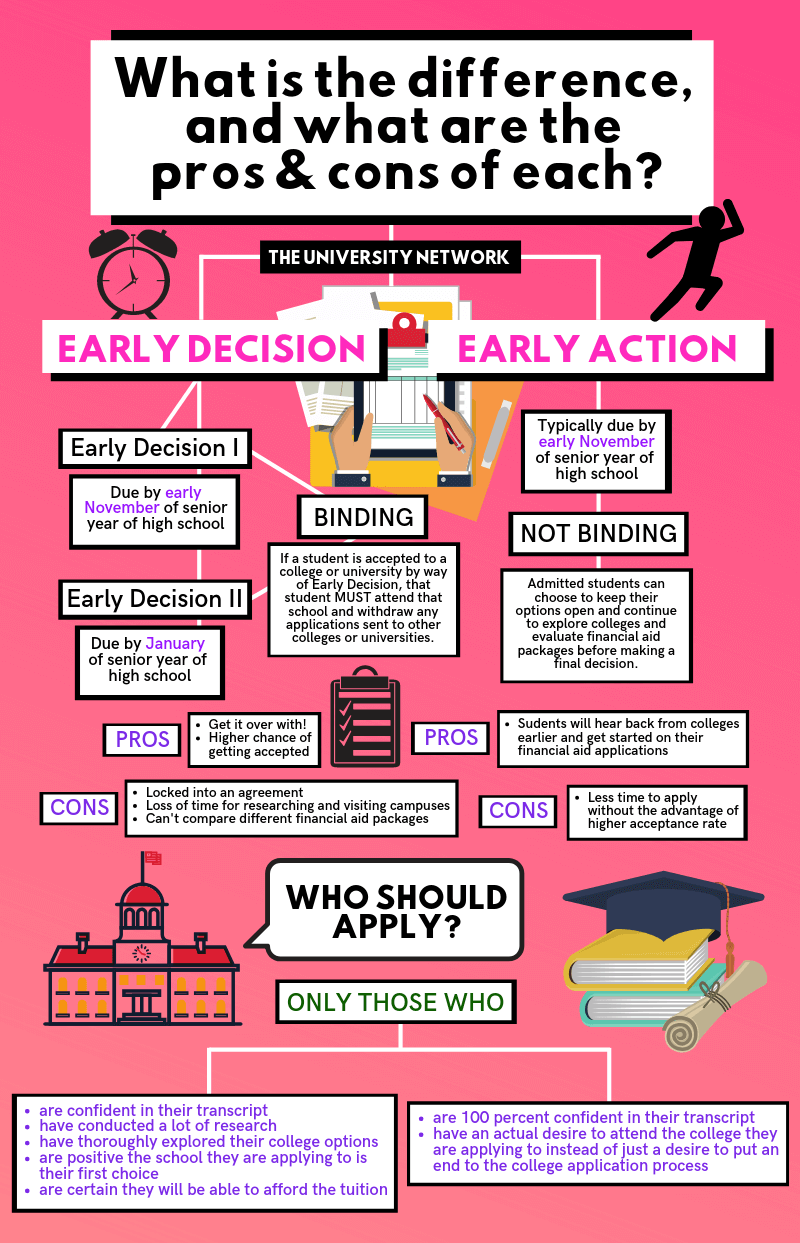There is more than one way to apply to college. Aside from Regular Decision, applicants may also have the option of applying Early Decision or Early Action.
For many applicants, choosing to take one of these non-traditional paths to enrollment can be very beneficial — and even improve their chances of acceptance. But for others, choosing to apply Early Decision or Early Action can be a mistake.
So, how will students know what’s the best way for them?
We spoke with experts and evaluated admissions data and policies from multiple public, private and Ivy League colleges and universities and came up with several key points that will help students make informed decisions on whether they should apply Early Decision, Early Action or Regular Decision.
Here’s what students should know to help them make a decision.

#1 — What you need to know about “Early Decision”
What is Early Decision?
Many colleges and universities — especially competitive ones — allow applicants to submit an Early Decision application by early November of their senior year of high school. But these application plans are binding, meaning, if a student is accepted to a college or university by way of Early Decision, that student MUST attend that school and withdraw any applications sent to other colleges or universities.
A few colleges and universities also offer students the option of applying by way of Early Decision II. Like Early Decision, this application plan is binding, but the main difference is in the timing. While those who choose Early Decision have to apply by early November, Early Decision II applicants don’t have to have their applications in until January. Generally, Early Decision II is an option best fit for students who were rejected by the college or university they applied Early Decision to, or for those who are dedicated to one specific school but need to boost their grades or test scores before applying.
What are the benefits of applying Early Decision?
Aside from potentially being done with the college application process early, the primary benefit of applying Early Decision is that it typically increases a student’s likelihood of being accepted.
“Certainly colleges want to bring in classes of students who are going to thrive there,” said Ryan Cassell, president of the Southern Association for College Admission Counseling (SACAC). “And if a student is applying Early Decision, that is a commitment to enroll. In most situations, applying Early Decision would have a positive benefit on a student’s likelihood of admission.”
For example, Duke University accepted 16.5 percent of students who applied Early Decision for the Class of 2027. In contrast, only 4.8 percent of students who applied Regular Decision were admitted.
It is important to note, however, that applicants still have to meet a college or university’s admissions criteria to have a chance at acceptance.
Applying Early Decision won’t help, say, a C- student get into an Ivy League school, suggested Joe Korfmacher, a director of counseling at Collegewise, the nation’s largest college counseling organization.
What are the disadvantages of applying Early Decision?
Korfmacher expresses two factors that students should understand before deciding to apply Early Decision.
First, students should carefully consider what it means to be locked into an agreement to attend a school. Typically, when students apply Early Decision, they receive their acceptance or denial letter by December of their senior year. (Students who apply Early Decision II generally receive a decision by February.) Those who choose Regular Decision, on the other hand, don’t have to decide which school they will attend until May 1.
Therefore, Early Decision students lose six months of valuable time that they could use to research schools, visit campuses and reflect on their college decision, Korfmacher explained.
The second factor is financial. When students opt to apply Early Decision, they also commit to a financial agreement. Soon after the acceptance letter comes, students and their families can expect papers explaining how much attending that college or university will cost.
“Sometimes that is going to be a surprise to families,” Korfmacher said. “They may be expected to pay much more than they actually can afford, and that can create some uncomfortable conversations.”
Additionally, because students who are accepted after applying Early Decision are committed to attendance, they lose the ability to compare financial packages from multiple colleges and make the smartest financial decision.
“I always tell families, if money is not an issue, that’s one thing,” Korfmacher said. “But for most families, it is a concern and part of something they are factoring in, so they should absolutely talk to the college financial aid departments before applying Early Decision. Some schools will give families an early read, basically telling them ‘if accepted, you can expect to pay this much out of pocket.’ Not every college will do that, but it is worth asking.”
Many colleges and universities also have net price calculators built into their websites that applicants and their families can check to get a rough estimate on how much they can expect to pay, Korfmacher suggested.
Who should apply Early Decision?
Students should only consider applying Early Decision if they are confident in their transcript, have conducted a lot of research, thoroughly explored their college options, are positive the school they are applying to is their first choice, and are certain they will be able to afford the tuition.
#2 — What you need to know about “Early Action”
What is Early Action?
Like Early Decision, students who opt to apply Early Action can expect to hear back from college admissions offices earlier than those who apply Regular Decision. However, unlike Early Decision, Early Action plans are not binding, so admitted students can choose to keep their options open and continue to explore colleges and evaluate financial aid packages before making a final decision.
Although it varies by school, those who choose to apply Early Action typically have to send in their applications by early November of their senior year of high school, and they can expect to hear back by early December. Those who choose to apply Regular Decision, on the other hand, typically have to submit their applications before February 1st, and they will typically hear back by around April 1st.
What are the benefits of applying Early Action?
When it comes to applying Early Action, the main benefit is that students will hear back from colleges earlier.
Aside from being a huge relief, being accepted to college early on in senior year enables students to enjoy the rest of high school, concentrate on their remaining courses, and turn their focus toward financial aid applications, among other things.
And if students are rejected, they still have time to apply to other colleges.
“(Early Action) is for students who are happy with where their grades are, happy with their test scores, and are ready to apply,” Korfmacher said.
Another benefit of applying Early Action is it gives students more time to decide between schools. Those who apply Early Action can still typically wait until May 1 to commit to a college — the same day as students who apply Regular Decision. So, applying Early Action is a good idea for those who are indecisive about where they want to go to school and need some extra time to figure it out.
“You can find out by December, as opposed to waiting until March or April, so it gives you much more time to get those applications in, continue to do that research, maybe visit the schools again and decide. It gives you more time to make an educated decision on where you want to attend college,” Korfmacher added.
Unlike Early Decision applications, however, applying Early Action does not increase a student’s likelihood of acceptance. This point is displayed on multiple university’s websites, including that of the University of Michigan.
What are the disadvantages of applying Early Action?
The college application process can be grueling and tiresome, so it’s normal for applicants to want to get it out of the way by applying early.
However, applicants should only consider Early Action if they feel confident and ready to submit their application.
“If they aren’t putting their best foot forward when they are applying Early Action, that is a disadvantage, because they will be reviewed based on whatever they are sending in,” Korfmacher said. “So, if they can wait a little longer to get some higher test scores in, or maybe good first quarter or semester grades and apply Regular Decision, that will be an advantage for them.”
It is important to note, however, that colleges and universities have different application deadlines. Some schools’ Early Action deadlines fall after the first quarter grading period ends. So, students should always consider including first quarter grades in their applications, even when applying early.
Who should apply Early Action?
Applicants should only consider Early Action if they are 100 percent confident in their transcript and have a desire to attend the college they are applying to.
Some students will make the mistake of applying Early Action just for the sake of putting an end to the college application process. But it is important to remember that rejection letters are irreversible, so students should not rush into the application process if they aren’t ready.
In conclusion
Primarily, applying Early Decision or Early Action is beneficial to students who have done their research, are content with the quality of their transcript, and have narrowed down, with certainty, the school — or short list of schools — that they want to attend.
Applicants should use these preceding guidelines to help them to decide the best way for them to apply. But it is important to remember that not every college or university follows the same admissions policies, so students should feel within their rights to ask more specific questions to admissions offices, Cassell said.



